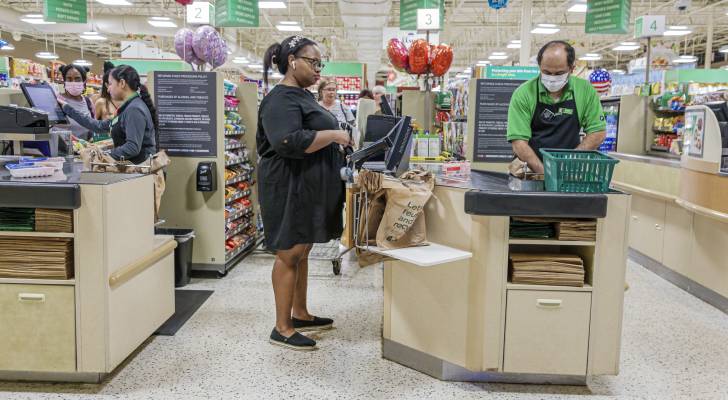
Few places reflect the state of America’s economy more clearly than the grocery store — and right now, it’s a painful reality check.
Food prices have soared to record post-pandemic highs, squeezing shoppers nationwide. Ground beef is up 12.8%. (1) Ground coffee? A jaw-dropping 20.9%. In New York, software engineer Kevin Lin was shocked to see ribeye steak selling for $32.99 a pound — far higher than it was just weeks ago.
Must Read
- Thanks to Jeff Bezos, you can now become a landlord for as little as $100 — and no, you don’t have to deal with tenants or fix freezers. Here’s how
- Dave Ramsey warns nearly 50% of Americans are making 1 big Social Security mistake — here’s what it is and 3 simple steps to fix it ASAP
- Robert Kiyosaki says this 1 asset will surge 400% in a year — and he begs investors not to miss its ‘explosion’
And consumers aren’t keeping quiet.
“It feels terrible,” Lin told The Wall Street Journal, adding that he even complained to his butcher.
In Cincinnati, Mark Bookbinder, 68, said he’s watched prices climb on staples like deli turkey, cereal and yogurt — calling it “perturbing and upsetting.”
The blame doesn’t fall on a single shelf. Rising commodity costs and President Trump’s tariffs on imported goods are driving up prices on household staples like olive oil, shrimp, and bananas. (3) Whatever’s fueling the surge, grocery chains say frustrated shoppers are changing how they spend, what they buy and where they shop.
How are shoppers changing their habits?
While grocery prices haven’t quite reached the record highs seen during the pandemic, they’re high enough to make people rethink their habits in the food aisle. (3)
Grocery chains report shoppers are buying smaller quantities of items, using more coupons and sticking to their lists.
“We see them sticking closer to their shopping list, maybe not buying that extra item, that extra bottle of whatever,” Albertsons Chief Executive Susan Morris said on a recent earnings call.
Other retailers report customers making more frequent trips to the store but buying less each time — buying only what they need to cook at home and focusing on fresh produce and basics. Dirk Van de Put, CEO of Oreo-maker Mondelez International, said grocery spending hasn’t increased in more than two years.
“They have no inclination to increase their spending,” Van de Put told The Wall Street Journal. “They’re unsure about what’s going to happen, when those tariff effects really are going to hit them.”
Some shoppers who were once loyal to local stores and butchers are turning to bulk retailers and warehouse clubs to save a few bucks. Costco, Sam’s Club and BJ’s are expanding to meet higher membership demand as consumers look for deals not just on groceries, but also on household goods and gas. (4)
For some, the savings make it possible to splurge a little again. Patrick Bannon, a 29-year-old Boston graduate student, said he joined Costco to save on essentials like groceries and trash bags but now he finds himself adding snacks, fancy coffee and even clothing to his cart.
“You get to be a kid in the candy store again,” he told CNBC. “Except it’s not all candy.”
Read more: I’m almost 50 and have nothing saved for retirement — what now? Don’t panic. These 6 easy steps can help you turn things around
How you can beat the high prices
With prices this high, everyone’s wondering how to trim a few dollars off the grocery bill. Even if you don’t have access to a warehouse club — or room to store bulk buys — there are plenty of ways to save.
One of the best: make a list and stick to it. (5) Grocery shopping with a plan helps you avoid impulse purchases and prevents you from buying ingredients you already have at home. Lists help keep you on budget, let you estimate your total before checkout and even cut down on food waste. They’re also great tools for meal prep — and can help you eat healthier too, since those spur-of-the-moment buys are often snacks and sweets. (6)
Beyond sticking to a list, tweak a few other habits. Opt for store-brand pantry staples to save 25 to 30%. (7) Take advantage of weekly sales, join loyalty programs and clip coupons before you shop.
While frozen meals and pre-cut vegetables are convenient, they often come with a markup. Sticking to the basics and cooking at home will almost always be the more affordable and rewarding choice. (7)
What to read next
- Are you richer than you think? 5 clear signs you’re punching way above the average American’s wealth
- Dave Ramsey says this 7-step plan ‘works every single time’ to kill debt, get rich — and ‘anyone’ can do it
- This tiny hot Costco item has skyrocketed 74% in price in under 2 years — but now the retail giant is restricting purchase. Here’s how to buy the coveted asset in bulk
- 22 US states are now in a recession or close to it — protect your savings with these 5 essential money moves ASAP
Join 200,000+ readers and get Moneywise’s best stories and exclusive interviews first — clear insights curated and delivered weekly. Subscribe now.
Article sources
We rely only on vetted sources and credible third-party reporting. For details, see our editorial ethics and guidelines.
Wall Street Journal (1, 2); Tax Foundation (3); The Food Industry Association (3); CNBC (4); National Library of Medicine (5); KSL Utah (6); SoFi (7
This article originally appeared on Moneywise.com under the title: Record-high food prices have Americans rethinking how they shop — but is sticking to a list really the best way to save?
This article provides information only and should not be construed as advice. It is provided without warranty of any kind.